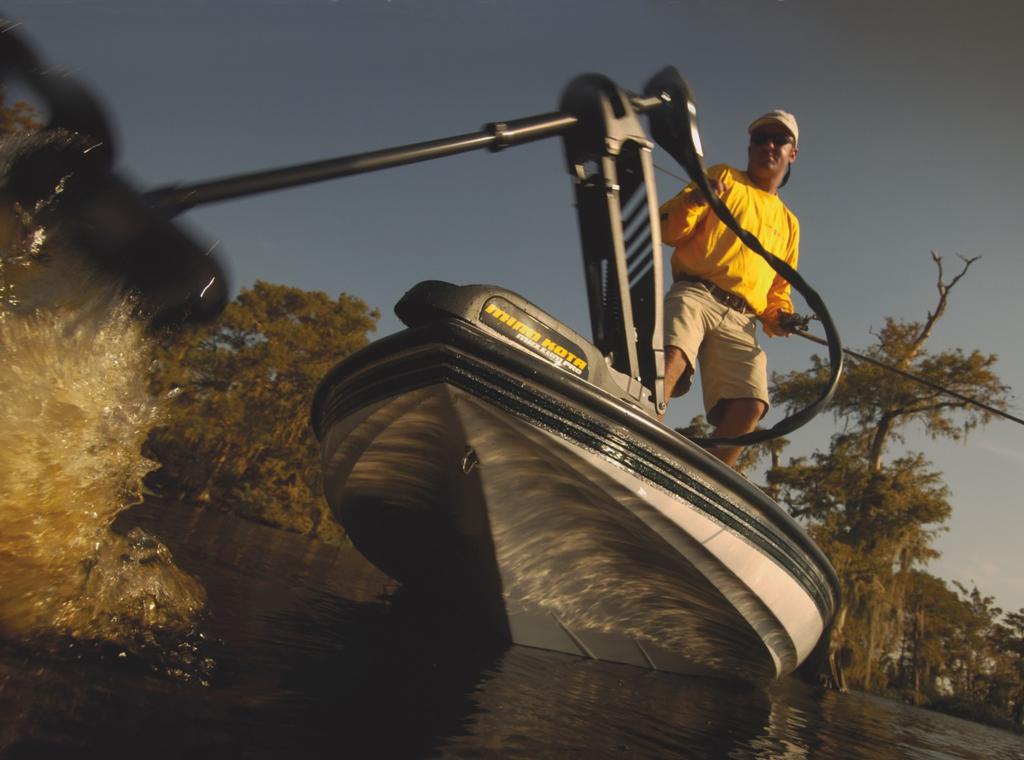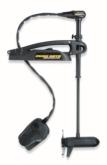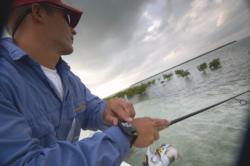Timeline: Hummin’ along
Modern advances in trolling motors breed better, more efficient function

Remember a decade ago when the best electric trolling motor was a 24-volt model – two batteries – that generated 55 pounds of thrust? In retrospect, you might also remember how battery power, though a huge improvement over the oomph supplied to glorified eggbeaters a decade before that, was lacking for a full day’s worth of pedal-to-the-medal maneuvering.
Since then, advances in trolling-motor design have made for far bigger blasters so energy efficient that deep-cycle batteries often have enough juice left to go another couple of days. Beyond the parameters of power and run time, among the features on new-and-improved electrics are composite shafts that bend but don’t break, die-cast marine-grade aluminum elsewhere in the construction for greater durability and the option for compass-driven remote steering with either a foot pedal or a remote control.
How did we get here? Consider the department of energy on Minn Kota trolling motors, which has hastened the move in power regulation and delivery from a speed coil to pulse-width modulation. Trolling motors of yore, if you remember, clicked from one speed to another under the guidance and direction of a speed coil. A speed coil, however, is analogous to driving a car with one foot on the gas and another on the brake – an inefficient method of voltage management that turned excess energy into heat, a stumbling block to trolling motor longevity. “Heat is the enemy,” says Joe Brown, brand manager of Minn Kota Trolling Motors. “Heat is a bad thing.” On the other hand, pulse-width modulation, that stems from Minn Kota’s mid-90s release of Maximizer technology that has become standard on the company’s motors, diminishes excess heat by more efficiently delivering the electrical current needed for a given amount of power. Trolling motors no longer click from one power level to the next due to infinite variability that comes with pulse-width modulation; turning down the rheostat for less power is like letting your foot off the gas on an automobile.
 With greater energy efficiency, today’s trolling motors have therefore gained greater power with multiple batteries that have replaced a single 12-volt power source for higher thrust. Back in 1995, the nascent move to a 24-volt Minn Kota was delivering a maximum 55 pounds of thrust; a comparable modern Maxxum generates 80 pounds on two batteries. Truth be told, two batteries back then was a big deal. For that matter, the forthcoming ’06 Maxxum Pro Bow-Mount supplies a hale and hearty 101 pounds of thrust on three batteries. Furthermore, Lift-Assist, a system of gas-charged springs, cuts the weight in half when lifting it from the water and will be added to select Riptide saltwater bowmounts for ’06.
With greater energy efficiency, today’s trolling motors have therefore gained greater power with multiple batteries that have replaced a single 12-volt power source for higher thrust. Back in 1995, the nascent move to a 24-volt Minn Kota was delivering a maximum 55 pounds of thrust; a comparable modern Maxxum generates 80 pounds on two batteries. Truth be told, two batteries back then was a big deal. For that matter, the forthcoming ’06 Maxxum Pro Bow-Mount supplies a hale and hearty 101 pounds of thrust on three batteries. Furthermore, Lift-Assist, a system of gas-charged springs, cuts the weight in half when lifting it from the water and will be added to select Riptide saltwater bowmounts for ’06.
Performance and durability
If energy efficiency and, in turn, greater power are hallmarks of modern trolling motors, additional upgrades round out the Minn Kota repertoire for better performance and improved durability. For instance, the division of Johnson Outdoors has transitioned away from stainless-steel shafts to a pultruded composite that is able to withstand bumps and bruises should it collide with a rock or log. A stainless-steel shaft, on the other hand, is prone to bending, and will weaken the cable-drive mechanism.
 In the meantime, AutoPilot likewise qualifies among advances in the product line. With a compass system to guide the boat in a given direction, AutoPilot in freshwater as well as saltwater offerings automatically and continuously makes adjustments to keep your boat going there – an advantage in hands-free operation when, for example, you’re fighting or unhooking a fish. A complementary component is CoPilot, a wireless remote control that can be affixed to a fishing rod or a wrist, like a watch, to steer from anywhere in the boat and change speed by dialing the power up or down.
In the meantime, AutoPilot likewise qualifies among advances in the product line. With a compass system to guide the boat in a given direction, AutoPilot in freshwater as well as saltwater offerings automatically and continuously makes adjustments to keep your boat going there – an advantage in hands-free operation when, for example, you’re fighting or unhooking a fish. A complementary component is CoPilot, a wireless remote control that can be affixed to a fishing rod or a wrist, like a watch, to steer from anywhere in the boat and change speed by dialing the power up or down.
Yes, today’s trolling motors are bigger and more powerful because of improved energy efficiency. They are also gaining greater longevity with better engineering in their components – for instance, the new Weedless Wedge prop on Maxxum Pros for slicing weeds. Another option on many Minn Kotas, Universal Sonar incorporates a transducer into the motor’s lower unit to offer plug-in compatibility with an array of fish finders. Undoubtedly, today’s biggest, baddest electric motors go where no trolling motor has gone before because of the difference a mere decade makes.
